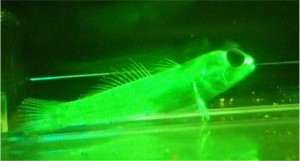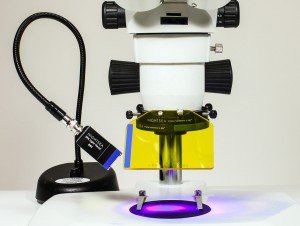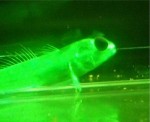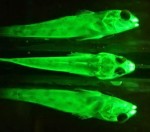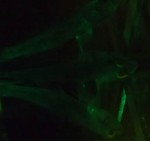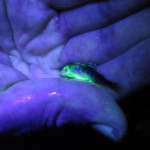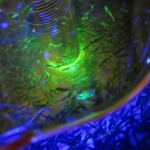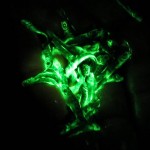Detect Calcein-Stained Fish
The NIGHTSEA Royal Blue excitation sources, combined with the appropriate barrier filters, are proven gear for detecting the green fluorescence of calcein-marked fish.
We offer two primary products for this task:
- Xite-RB Flashlight– a simple flashlight + filter glasses combination for detection by eye
- Stereo Microscope Fluorescence Adapter – an economical way to use existing conventional stereo microscopes for fluorescence work
- Recommended – Model SFA-RB, with Royal Blue (440 – 460nm) excitation and the longpass filter
Visit the web pages for these products for further information, or contact us directly if you have any questions.
How to Order – Our products are distributed through Electron Microscopy Sciences (EMS). The following links will take you directly to these products on their web site:
More on calcein marking
Methodologies for the mass marking of larval or juvenile fishes are needed for various studies, such as assessing the success of fish stock supplementation programs. A promising treatment involves immersing fishes in a solution of calcein, a fluorochrome compound that chemically binds with alkaline earth metals such as calcium, and upon binding, shows a marked increase in fluorescence . This treatment marks otoliths and also produces a brilliant green fluorescence in fin rays and scales. Once fish have been marked you need a means to distinguish marked from unmarked individuals, and that is where the NIGHTSEA gear comes in.
The images below were provided by researchers who conducted calcein studies with the NIGHTSEA flashlights. One used it in a mark/recapture study, detecting calcein-marked rainbow trout (Oncorhynchus mykiss) fry in their streamside incubator facility. Drs. Kelly Grant and Greg Andraso of Gannon University (Erie, PA) used it successfully with round gobies (Neogobius melanostomus), an invasive fish in the Great Lakes.
(Click images for larger view and more information)
- Round goby (c) Greg Andraso / Kelly Grant
- Calcein stained round goby (c) Greg Andraso / Kelly Grant
- Round goby (unstained) (c) Greg Andraso / Kelly Grant
- Rainbow trout (c) Heidi Isner
- Rainbow trout (c) Heidi Isner
- Rainbow trout (c) Heidi Isner
In addition to the whole-animal imaging described above, some researchers need to look at calcein-stained specimens in greater detail. The NIGHTSEA Stereo Microscope Fluorescence Adapter is an economical way to add a fluorescence capability to virtually any existing stereo microscope. Dr. Maria Abate of Simmons College is using the fluorescence adapter with calcein for a laboratory study of the effect of growth environment on bone development in zebrafish. While there are now 6 different excitation/emission combinations offered with that system, for calcein work you only need the Royal Blue combination, the same wavelengths that are used in the GoBe and filter glasses.
Note: The NIGHTSEA flashlights and the Stereo Microscope Fluorescence Adapter system are not endorsed by U. S. Fish & Wildlife or Gannon University
Calcein information
Calcein staining of fish to be released into the wild is not yet approved for general use. It is being studied as an Investigational New Animal Drug (INAD), collecting the data that will be used to support a new animal drug application (NADA). The study is being overseen by the Aquatic Animal Drug Approval Partnership Program (AADAP) at the U. S. Fish & Wildlife Service. If you are interested in using SE-MARK (calcein solution) to mass mark fish, please contact the AADAP office.
Powerpoint presentation by Jerre W. Mohler, US Fish & Wildlife Service, Northeast Fishery Center

